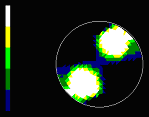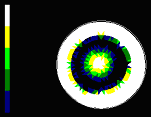|
|
|
Electrical capacitance tomography
|
Electrical capacitance tomography (ECT) is an imaging technique for visualising industrial processes containing dielectric materials.
ECT was the first developed and is the most mature among various modalities of industrial process
tomography. It can be used to investigate the internal dynamic behaviour by presenting cross-sectional
distribution of materials, i.e. tomographic images, which
is similar to CT scanners used in hospitals. The pictures below show
tomographic images reconstructed with experimental data where white
colour represents high permittivity material and black colour
represents low permittivity material.
| True distribution |
 |
 |
 |
| Reconstructed
image |
 |
 |
 |
ECT has several advantages over other tomography modalities, such as low cost, fast response,
no radiation, non-intrusive and non-invasive, and robust in hostile
environments with high temperature and high pressure. ECT has been used for many industrial applications, such as imaging of gas-oil flows in oil pipelines, gas-solids distribution in pneumatic conveyors and fluidised beds, combustion flame in engine cylinders and liquid droplets distribution in wet gas
separators.
In 1991, the first real-time ECT system was developed, based on a charge/discharge capacitance measuring circuit and
Transputers. Although this system was used successfully in some cases, it has some problems:
- The system needs frequent calibration due to charge injection of CMOS switches.
- The charge/discharge circuit can only measure the mixed
impedance, not true capacitance when loss conductance presents.
- The measurement protocol is fixed and the number of measurement
channels is limited by hardware.
- The system was designed to operate with Transputers, which are no longer available.
To overcome the above problems, ECT Instruments Ltd has
developed the state-of-the-art ACECT system.
|
|

